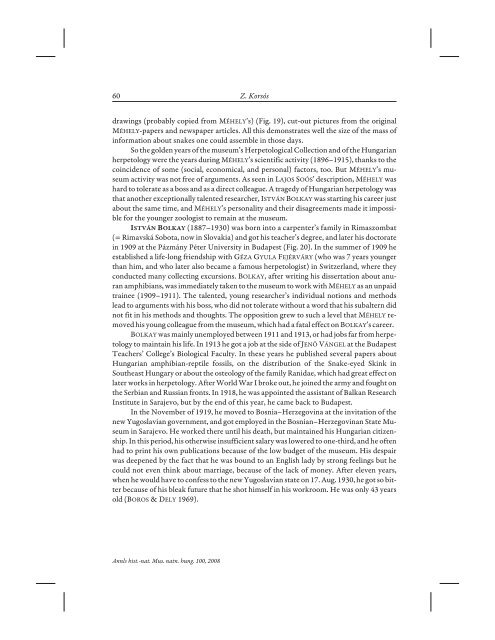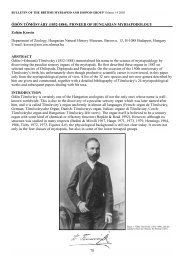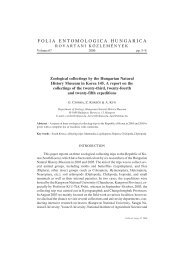History of the Herpetological Collection of the ... - Korsós Zoltán
History of the Herpetological Collection of the ... - Korsós Zoltán
History of the Herpetological Collection of the ... - Korsós Zoltán
You also want an ePaper? Increase the reach of your titles
YUMPU automatically turns print PDFs into web optimized ePapers that Google loves.
60 Z. Korsós<br />
drawings (probably copied from MÉHELY’s) (Fig. 19), cut-out pictures from <strong>the</strong> original<br />
MÉHELY-papers and newspaper articles. All this demonstrates well <strong>the</strong> size <strong>of</strong> <strong>the</strong> mass <strong>of</strong><br />
information about snakes one could assemble in those days.<br />
So <strong>the</strong> golden years <strong>of</strong> <strong>the</strong> museum’s <strong>Herpetological</strong> <strong>Collection</strong> and <strong>of</strong> <strong>the</strong> Hungarian<br />
herpetology were <strong>the</strong> years during MÉHELY’s scientific activity (1896–1915), thanks to <strong>the</strong><br />
coincidence <strong>of</strong> some (social, economical, and personal) factors, too. But MÉHELY’s museum<br />
activity was not free <strong>of</strong> arguments. As seen in LAJOS SOÓS’ description, MÉHELY was<br />
hard to tolerate as a boss and as a direct colleague. A tragedy <strong>of</strong> Hungarian herpetology was<br />
that ano<strong>the</strong>r exceptionally talented researcher, ISTVÁN BOLKAY was starting his career just<br />
about <strong>the</strong> same time, and MÉHELY’s personality and <strong>the</strong>ir disagreements made it impossible<br />
for <strong>the</strong> younger zoologist to remain at <strong>the</strong> museum.<br />
(1887–1930) was born into a carpenter’s family in Rimaszombat<br />
(= Rimavská Sobota, now in Slovakia) and got his teacher’s degree, and later his doctorate<br />
in 1909 at <strong>the</strong> Pázmány Péter University in Budapest (Fig. 20). In <strong>the</strong> summer <strong>of</strong> 1909 he<br />
established a life-long friendship with GÉZA GYULA FEJÉRVÁRY (who was 7 years younger<br />
than him, and who later also became a famous herpetologist) in Switzerland, where <strong>the</strong>y<br />
conducted many collecting excursions. BOLKAY, after writing his dissertation about anuran<br />
amphibians, was immediately taken to <strong>the</strong> museum to work with MÉHELY as an unpaid<br />
trainee (1909–1911). The talented, young researcher’s individual notions and methods<br />
lead to arguments with his boss, who did not tolerate without a word that his subaltern did<br />
not fit in his methods and thoughts. The opposition grew to such a level that MÉHELY removed<br />
his young colleague from <strong>the</strong> museum, which had a fatal effect on BOLKAY’s career.<br />
BOLKAY was mainly unemployed between 1911 and 1913, or had jobs far from herpetology<br />
to maintain his life. In 1913 he got a job at <strong>the</strong> side <strong>of</strong> JENÕ VÁNGEL at <strong>the</strong> Budapest<br />
Teachers’ College’s Biological Faculty. In <strong>the</strong>se years he published several papers about<br />
Hungarian amphibian-reptile fossils, on <strong>the</strong> distribution <strong>of</strong> <strong>the</strong> Snake-eyed Skink in<br />
Sou<strong>the</strong>ast Hungary or about <strong>the</strong> osteology <strong>of</strong> <strong>the</strong> family Ranidae, which had great effect on<br />
later works in herpetology. After World War I broke out, he joined <strong>the</strong> army and fought on<br />
<strong>the</strong> Serbian and Russian fronts. In 1918, he was appointed <strong>the</strong> assistant <strong>of</strong> Balkan Research<br />
Institute in Sarajevo, but by <strong>the</strong> end <strong>of</strong> this year, he came back to Budapest.<br />
In <strong>the</strong> November <strong>of</strong> 1919, he moved to Bosnia–Herzegovina at <strong>the</strong> invitation <strong>of</strong> <strong>the</strong><br />
new Yugoslavian government, and got employed in <strong>the</strong> Bosnian–Herzegovinan State Museum<br />
in Sarajevo. He worked <strong>the</strong>re until his death, but maintained his Hungarian citizenship.<br />
In this period, his o<strong>the</strong>rwise insufficient salary was lowered to one-third, and he <strong>of</strong>ten<br />
had to print his own publications because <strong>of</strong> <strong>the</strong> low budget <strong>of</strong> <strong>the</strong> museum. His despair<br />
was deepened by <strong>the</strong> fact that he was bound to an English lady by strong feelings but he<br />
could not even think about marriage, because <strong>of</strong> <strong>the</strong> lack <strong>of</strong> money. After eleven years,<br />
when he would have to confess to <strong>the</strong> new Yugoslavian state on 17. Aug. 1930, he got so bitter<br />
because <strong>of</strong> his bleak future that he shot himself in his workroom. He was only 43 years<br />
old (BOROS & DELY 1969).<br />
Annls hist.-nat. Mus. natn. hung. 100, 2008




